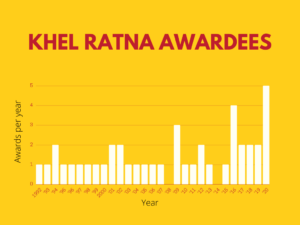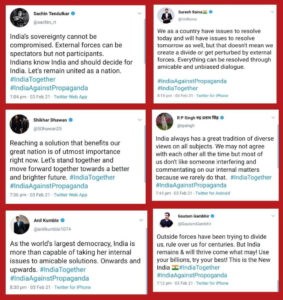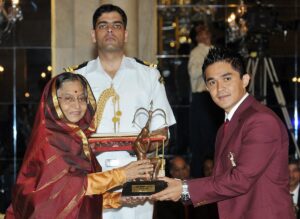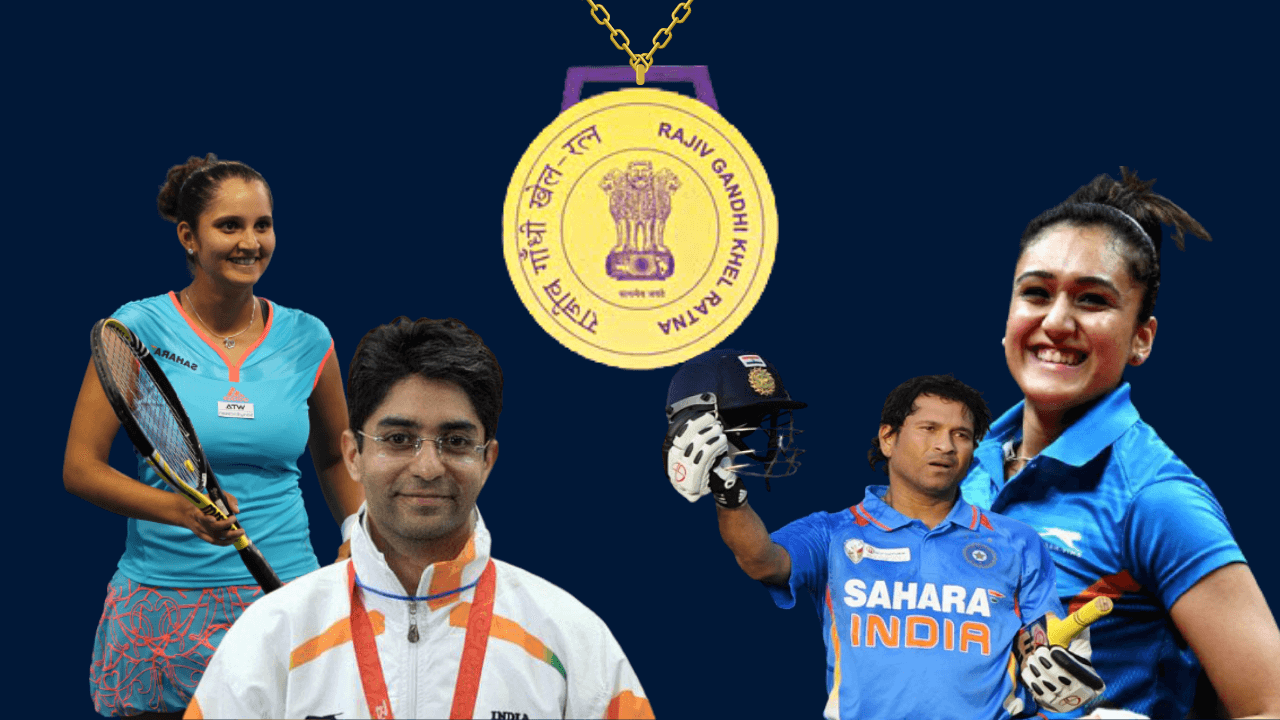“I was misquoted as saying I didn’t deserve it, but certainly at nineteen, while I was young and shooting well, I only had a World Cup bronze in my collection. ‘Deserving’ is a fair question, deserving should be rigorously debated. Awards are nice as long as in India we’re careful not to devalue them. Arjuna Awards were occasionally dispensed like out of a vending machine and the more freely we disperse them, the less valuable they become. Pure performance, over time, should determine awards, not sad lobbying by officials in dusty association rooms.”
Abhinav Bindra won India’s most prestigious sporting honour, the Rajiv Gandhi Khel Ratna, as a 19-year-old in 2001. Still in the early stages of his sporting prowess, he beat the likes of seasoned campaigners such as boxer Mary Kom, who had just won a Silver in the inaugural World Championship, shooter Anjali Bhagwat, who had multiple Gold medals from the World Commonwealth Championship, and tennis star Mahesh Bhupathi, who had already won at Wimbledon, the French Open, as well as the Australian Open in the years preceding 2001.
Instituted in 1991-92, the Rajiv Gandhi Khel Ratna Award in Sports and Games replaced the Arjuna Award as India’s top sporting honour. Winning the Khel Ratna signifies the Government’s recognition of one’s extraordinary sporting feats. Awardees receive ₹25 lakh as prize money (increased from the erstwhile ₹7.5 lakh, exempt from taxes), a certificate, a medallion, and other benefits such as subsidised travel by air and rail.
Ever since its inception, the Khel Ratna has been mired in controversies that include players’ lobbying, deserving athletes missing out, as well as an opaque selection policy. Despite the Khel Ratna Scheme mandating that only one award be given every year to an individual, in 2020, 5 different athletes were awarded India’s “most prestigious” sporting honour.

What makes five athletes receiving the award more concerning is the fact 2020 was a non-Olympic year, wherein very few of these athletes scaled new heights within their disciplines to justify the awards being an “exception”. The objective of the Khel Ratna is to recognise the “spectacular” and “most outstanding” performances by sportspersons in the year preceding the award. Admirable and pure as the objectives may read, the workings of the Award have drawn questions about its eminence. Is excellence actually being rewarded? How does one decide what is “outstanding”? Most importantly, does the Award set a high enough benchmark for Indian athletes to aspire towards?
Translating Good Intent into Meaningful Rewards
“Exclusivity creates want”, or so the adage goes. There has always been just one Oscar for the Best Actor, one Olympic Gold Medal for the fastest sprinter, and one World Cup for the best international team. This sense of exclusivity is what makes any award worth years of blood, sweat and tears.
“In general, the Khel Ratna is not a very difficult award to decide. You generally have 2-3 clear frontrunners, especially in an Olympic year,” says Neeru Bhatia, a sports journalist and the deputy chief of bureau at The Week magazine, over a phone interview. Bhatia was one of the 12 members in the selection committee for the national sports awards in 2020, which included the Khel Ratna and Arjuna awards.
Importantly, she adds that “although placing 4th in the Olympics is an admirable feat that deserves State recognition, it is not equal to winning an Olympic Gold. This is why there should be a sub-category within the Khel Ratna itself — it was a recommendation for the Sports Ministry that was made by the 2020 selection committee as well.” Her reasoning for these sub-categories of awards rests on the fact that India has become a multi-sport nation in the three decades since the Khel Ratna was instituted.
Just take something like the Asian Games alone. From being competitive in 3-4 sports like Hockey, Kabaddi, Archery, Wrestling, or Shooting, today we win medals even in sports like Gymnastics, Judo, Boxing, etc. As a consequence, the number of awards ought to increase.
So why do we reward athletes with the highest award for sport before they themselves have reached pinnacles of their craft? One can posit that awards in the form of state recognition encourages athletes to continue working hard, while inspiring the generations that follow. So, Abhinav Bindra’s Khel Ratna in 2001, awarded 7 years before his historic Olympic Gold, could be seen as a hefty hand of support — one that pushed him to hone his craft and bring more laurels for the country. Similarly, Vishwanathan Anand received the award in 1991-92, just after he had become a Grandmaster. His best sporting years lay ahead of him.
The concern with this forward-looking rationale is that the Khel Ratna Scheme mandatorily awards athletes for their past performances; that is, it rewards athletes’ achievements, not their prospects. Having sub-categories for awards could allow prospective medal winners to be felicitated, but that would demand adherence to stringent selection guidelines that are already opaque.
For example, the Khel Ratna is awarded for “spectacular” and “most outstanding” sporting performances over a period of four years. Its less-exclusive cousin, the Arjuna Award, is given for “consistently outstanding” performances over four years. The difference (or lack thereof) between “spectacular” or “most outstanding” with “consistently outstanding” makes these awards at risk of stoking controversy, as was seen when Sakshi Malik felt “broken”, for not winning the Arjuna Award, despite being awarded the more prestigious Khel Ratna earlier.
OK, so how are awards decided?
After a series of controversies and complaints regarding the selection criteria, in 2014, a point system was announced for the Khel Ratna Award.

While this is an attempt to maintain relatively objective criteria for selection, phrases saying that the “profile and standard of the sports events” would be considered for athletes that do not fall into the fold of an Olympic sport makes things ambiguous. Take the case from 2018, wherein Virat Kohli received the Khel Ratna award over Bajrang Punia, despite Punia having 80 points.
It is hard to imagine that there are no records or minutes of deliberations within the selection committee, especially when it is being chaired by a retired Supreme Court Justice. “There is always some element of lobbying with any award, but ultimately, it is [the athlete’s] performance that should matter,” Bhatia tells us. “They [the Department of Sports] should be putting [minutes] out.” It would be interesting to see the government’s responses to RTIs filed for accessing recordings of these meetings.
Just think about it: if the Sports Minister of the time decides that a certain athlete deserves to win an award (for whatever reason), then the bureaucrats involved in the selection committee will have no choice but to ensure that they receive the award. Even the Chairman of the selection committee is chosen by the Department of Sports.
If there is nothing to hide about a process whose scoring criteria and selectors have already been made public, what is the harm in making deliberations accessible? It will go a long way in creating trust within the sports fraternity while reducing the scope for lobbying and politicizing the country’s most prestigious sports award.
What’s “Moral Turpitude” got to do with it?
Just last week, as a series of tweets from international actors condemned the government’s handling of the farmer’s protests, a slew of Indian athletes came out with #IndiaAgainstPropaganda, defending the government in power and stoking nationalist sentiment.

While it is impossible to paint Indian athletes’ political intent with a broad stroke, prominent athletes have typically remained apolitical, and seldom speak out against the ruling establishment. There could be many reasons for this — most Olympic sports receive support and funding from the government, and others are reliant on government training facilities and coaches. However, another plausible reason for their behaviour comes from the fact that winning a sporting award (and the consequent public adulation) requires an athlete to maintain their “moral turpitude”.

‘Moral turpitude’ can be defined as “an act or behaviour that gravely violates the sentiment or accepted standard of the community”. To an observer, this seems like a subliminal mechanism for a Government to demand certain ‘favourable’ behaviour from athletes. But Bhatia sees no cause for concern. “In order to win the Khel Ratna, you should be a role model in your public life as well. Look at the likes of Abhinav Bindra… Cases, or even suggestions of corruption do not sit well with an award of this stature,” she says.
An example that comes to mind is the situation wherein the Badminton Association of India (BAI) refused to recommend Kidambi Srikanth and HS Prannoy for last year’s Khel Ratna and Arjuna awards respectively, on disciplinary grounds. Both athletes had pulled out from a team championship in Manila without taking permission. However, Srikanth’s nomination eventually went through, after the BAI issued a statement saying “We have received an email in which [Srikanth] has accepted the mistake and has also promised to not indulge in such activities in the future. Considering [Srikanth’s] talent and [his] accomplishments, we have decided to recommend his name for Rajiv Gandhi Khel Ratna Award”. Prannoy, who offered no such apology, was left fuming on the sidelines.
View this post on Instagram
Bhatia stands firm in her belief that these awards are not politically motivated. “You get an award for performing at the highest level and winning a medal. Political allegiance does not matter… Unless you are supporting a banned organisation or something of that nature, it is highly unlikely that the Government will deny awarding you. It is, after all, a medal won for the nation.”
On Relativity in Adjudication: Is Cricket given disproportionate importance?
Of the 43 Khel Ratna awards that have been presented to athletes, 4 of them have been to cricketers, which is the most out of all non-Olympic sports. For a sport that has only 12 full time international competitors, it begs the question as to whether India’s domination is somewhat over-rewarded as compared to other more (internationally) popular team sports. Sachin Tendulkar was presented the Khel Ratna back in 1997-98, when his standout achievement was being included amongst five cricketers as the Wisden Cricketers of the Year.
Look at the language of the scheme itself: it provides for special circumstances for Cricket, which is the only sport without a recognised National Sports Federation (NSF) that is allowed to be nominated for the award. Apart from this, the selection criteria present in the scheme specifically carves out an exception for cricket by allowing the Selection Committee to take into consideration individuals performances that are technically not linked to the point system that the scheme provides.
So, in 2020, Rohit Sharma received the Khel Ratna off the back of 556 runs in five Test matches, 1490 ODI runs, and the unprecedented feat of five centuries at a single World Cup. Yet, team India did not win any equivalent of a World Championship (unless you count Sharma’s IPL success). Bhatia is more sympathetic to cricketers’ cause. “It is not the fault of cricketers that it isn’t an Olympic sport. Cricket is a popular sport in India, and so it has to be duly recognised,” she says.

Conflate these figures with a sport like Football, which has an illustrious history in India, and over 210 active international teams. The likes of Sunil Chhetri, who has captained the team and scored 72 international goals from 115 appearances, is yet to receive recognition at the level of the Khel Ratna. He is the 2nd highest active goalscorer in international football, sandwiched between Lionel Messi and Cristiano Ronaldo, and what he has done for the popularity of the sport in India is remarkable. Point to note: only two other athletes from team sports have won the Khel Ratna, namely Dhanraj Pillay and Sardar Singh from Hockey.
Looking Ahead
Despite coming out with a point system, there are still question marks hanging over the exceptionality of the Khel Ratna, with Manika Batra coming under scrutiny. The paddler had no notable additions to her repertoire since winning the 2018 Arjuna Award; in fact, a year before being awarded the Khel Ratna in August 2020, her ranking dropped to 76th in the world. She also failed to help the women’s team qualify for the Olympics in Tokyo, slated for 2020.
At the end of the day, no sports fan likes to see their idols bicker after being snubbed from an award, and no awardee likes to feel like they did not rightfully earn their medal of honour. In the interest of bringing back its exclusivity and for incentivizing young athletes, the Khel Ratna must be conferred to truly outstanding sporting feats.
While our athletes deserve to be recognized for representing the country’s colours at international stages, there needs to be a more transparent standard for rewarding their achievements, especially when India’s top sporting honour is in question. Perhaps the recommendation of sub-categories could improve the system, alongside the release of recordings of the selection committee’s deliberation process.






